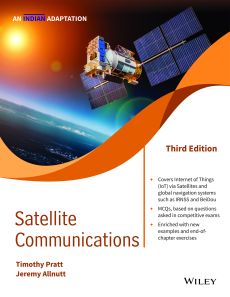Satellite Communications, 3ed, An Indian Adaptation
ISBN: 9789354243035
632 pages
For more information write to us at: acadmktg@wiley.com

Description
Satellite Communications is a comprehensive textbook designed for undergraduate and postgraduate courses on satellite communications. The book focuses on the underlying principles and essential mathematics required to understand the physics and engineering of satellite communications. Beginning with the topics that are specific to satellites, including orbits, launchers, and spacecraft, the book goes on to explain the principles of digital communication systems, radio frequency communications, digital modulation and multiple access techniques, and propagation in the earth's atmosphere, topics that are common to all radio communication systems.
1 Introduction
1.1 Background
1.2 A Brief History of Satellite Communications
1.3 Satellite Communications in 2020
1.4 Overview of Satellite Communications
1.5 Summary
1.6 Organization of This Book
2 Orbital Mechanics and Launchers
2.1 Introduction
2.2 Achieving a Stable Orbit
2.3 Kepler’s Three Laws of Planetary Motion
2.4 Describing the Orbit of a Satellite
2.5 Locating the Satellite in the Orbit
2.6 Locating the Satellite With Respect to the Earth
2.7 Orbital Elements
2.8 Look Angle Determination
2.9 Orbital Perturbations
2.10 Orbit Determination
2.11 Space Launch Vehicles and Rockets
2.13 Orbital Effects in the Performance of Communication Systems
2.14 Summary
3 Satellites
3.1 Satellite Subsystems
3.2 Attitude and Orbit Control System
3.3 Telemetry, Tracking, Command, and Monitoring
3.4 Power Systems
3.5 Communication Subsystems
3.6 Satellite Antennas
3.7 Equipment Reliability and Space Qualification
3.8 Summary
4 Satellite Link Design
4.1 Introduction
4.2 Transmission Theory
4.3 System Noise Temperature and G/T Ratio
4.4 Design of Downlinks
4.5 Uplink Design
4.6 Design for Specified CNR: Combining CNR and C/I Values in Satellite Links
4.7 Summary
5 Digital Transmission and Error Control
5.1 Digital Transmission
5.2 Implementing Zero ISI Transmission in the Time Domain
5.3 Probability of Error in Digital Transmission
5.4 Digital Transmission of Analog Signals 5.5 Time Division Multiplexing 5.6 Packets, Frames, and Protocols 5.7 Error Control 5.8 Summary 6 Modulation and Multiple Access 6.1 Introduction 6.2 Digital Modulation 6.3 Multiple Access 6.4 Frequency Division Multiple Access 6.5 Time Division Multiple Access 6.6 Synchronization in TDMA Networks 6.7 Star and Mesh Networks 6.8 Demand Assignment Multiple Access 6.9 Random Access 6.10 Packet Radio Systems and Protocols 6.11 Code Division Multiple Access 6.12 Summary 7 Propagation Effects on Satellite-Earth Links 7.1 Introduction 7.2 Propagation Phenomena 7.3 Quantifying Attenuation and Depolarization 7.4 Propagation Effects That Are Not Associated With Hydrometeors 7.5 Rain and Ice Effects 7.6 Propagation Impairment Countermeasures 7.7 Summary 8 Low Throughput Systems and Small Satellites 8.1 Introduction 8.2 Small Satellites 8.3 Operational Use of SmallSats 8.4 Low-Throughput Mobile Communication Satellite Systems 8.5 VSAT Systems 8.6 Time Over Coverage 8.7 Orbital Debris 8.8 Summary 9 NGSO Satellite Systems 9.1 Introduction 9.2 Orbit Considerations 9.3 Coverage and Frequency Considerations 9.4 System Design Example 9.5 Summary 10 Satellite Television 10.1 C-Band and Ku-Band Home Satellite TV 10.2 Digital DBS-TV 10.3 DVB-S and DVB-S2 Standards 10.4 DBS-TV System Design 10.5 DBS-TV Link Budget for DVB-S and DVB-S2 Receivers 10.6 Second-Generation DBS-TV Satellite Systems Using DVB-S Signal Format 10.7 Master Control Station and Uplink 10.8 Summary 11 Satellite Internet 11.1 History of Satellite Internet Access 11.2 Geostationary Satellite Internet Access 11.3 NGSO Satellite Systems 11.4 Link Budgets for NGSO Systems 11.5 Packets and Protocols for NGSO Systems 11.6 Gateways, User Terminals, and Onboard Processing Satellites 11.7 End-of-Life Disposal of NGSO Satellites 11.8 User Terminal Antennas for Ku-Band, Ka-Band, and V-Band 11.9 IoT via Satellite 11.10 Summary 12 Satellite Navigation Systems 12.1 The Global Positioning System 12.2 Other Global Navigation Satellite Systems 12.3 Radio and Satellite Navigation 12.4 GPS Position Location Principles 12.5 GPS Codes and Frequencies 12.6 Satellite Signal Acquisition 12.7 GPS Signal Levels 12.8 GPS Navigation Message 12.9 GPS C/A Code Standard Positioning System Accuracy 12.10 Denial of Service: Jamming and Spoofing 12.11 Summary Exercises Multiple Choice Questions References Appendices A Decibels in Communications Engineering B Antennas B.1 Introduction B.2 Gain and Beamwidth B.3 Polarization B.4 Low-Gain, Medium-Gain, and High-Gain Antennas B.5 Small Antennas B.6 Reflector Antennas B.7 Antenna Theory B.8 Multiple Beam Antennas B.9 Phased Arrays B.10 Phase Shifters C Complementary Error Function erfc(x) and Q Function Q(z) C.1 Equivalence Formulas and Tables of Values D Digital Transmission of Analog Signals D.1 Sampling D.2 Bandpass Sampling D.3 Digital Transmission D.4 Non-uniform Quantization: Compression and Expansion D.5 Reducing the Bandwidth of Digital Signals References Glossary Index |

